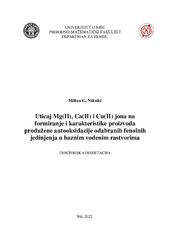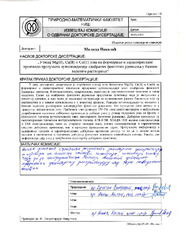Приказ основних података о дисертацији
Uticaj Mg(II), Ca (II) i Cu(II) jona na formiranje i karakteristike proizvoda produžene autooksidacije odabranih fenolnih jedinjenja u baznim vodenim rastvorima
| dc.contributor.advisor | Krstić, Nenad | |
| dc.contributor.other | Mitić, Žarko | |
| dc.contributor.other | Đorđević, Dragan | |
| dc.creator | Nikolić, Milica | |
| dc.date.accessioned | 2023-02-15T20:35:30Z | |
| dc.date.available | 2023-02-15T20:35:30Z | |
| dc.date.issued | 2022 | |
| dc.identifier.uri | http://eteze.ni.ac.rs/application/showtheses?thesesId=8562 | |
| dc.identifier.uri | https://fedorani.ni.ac.rs/fedora/get/o:1837/bdef:Content/download | |
| dc.identifier.uri | https://plus.cobiss.net/cobiss/sr/sr/bib/67507209 | |
| dc.identifier.uri | https://nardus.mpn.gov.rs/handle/123456789/21175 | |
| dc.description.abstract | The goal of this doctoral dissertation is to determine the influence of the Mg(II), Ca(II) and Cu(II) ions on the formation and characteristics of products resulting from prolonged autoxidation of selected phenolic compounds: catechol, 4-methylcatechol, hydroquinone, pyrogallol, protocatechuic acid, and gallic acid. These specific phenolic compounds have been chosen because of their presence in both biological systems and the environment. Furthermore, the ubiquitous presence of aforementioned biometal ions in these environments enables their interaction. Autoxidation reactions were carried out in alkaline aqueous solutions of the particular phenolic compound both in the absence and in the presence of individual metal ion. Following of the reaction flow using UV-Vis spectrophotometry and comparing yields of the obtained products gave insight into the influence of each of the metal ions used on the rate and efficiency of the autoxidation process of these diverse phenolic compounds. Obtained products are characterized using ATR-FTIR, MALDI-TOF mass spectrometry and ESR spectroscopy. These techniques allowed the determination of molar masses, degree of polymerization, and paramagnetic properties of the products, as well as the presence of specific functional groups. Data acquired during the autoxidation process along with characteristics of obtained products point to this method being a valid and economically more viable alternative to production of phenolic polymers using enzymes. This data also gives insight in the possible applications of the obtained products. | en |
| dc.format | application/pdf | |
| dc.language | sr | |
| dc.publisher | Универзитет у Нишу, Природно-математички факултет | sr |
| dc.rights | openAccess | en |
| dc.rights.uri | https://creativecommons.org/licenses/by-nc-nd/4.0/ | |
| dc.source | Универзитет у Нишу | sr |
| dc.subject | autooksidacija | sr |
| dc.subject | autoxidation | en |
| dc.subject | biometal ions | en |
| dc.subject | catechol | en |
| dc.subject | 4-methylcatechol | en |
| dc.subject | hydroquinone | en |
| dc.subject | pyrogallol | en |
| dc.subject | protocatechuic acid | en |
| dc.subject | gallic acid | en |
| dc.subject | phenolic polymers | en |
| dc.subject | joni biometala | sr |
| dc.subject | katehol | sr |
| dc.subject | 4-metilkatehol | sr |
| dc.subject | hidrohinon | sr |
| dc.subject | pirogalol | sr |
| dc.subject | protokatehinska kiselina | sr |
| dc.subject | galna kiselina | sr |
| dc.subject | fenolni polimeri | sr |
| dc.title | Uticaj Mg(II), Ca (II) i Cu(II) jona na formiranje i karakteristike proizvoda produžene autooksidacije odabranih fenolnih jedinjenja u baznim vodenim rastvorima | sr |
| dc.type | doctoralThesis | |
| dc.rights.license | BY-NC-ND | |
| dc.identifier.fulltext | http://nardus.mpn.gov.rs/bitstream/id/149417/Nikolic_Milica_G.pdf | |
| dc.identifier.fulltext | http://nardus.mpn.gov.rs/bitstream/id/149416/Doctoral_thesis_13229.pdf | |
| dc.identifier.rcub | https://hdl.handle.net/21.15107/rcub_nardus_21175 |



